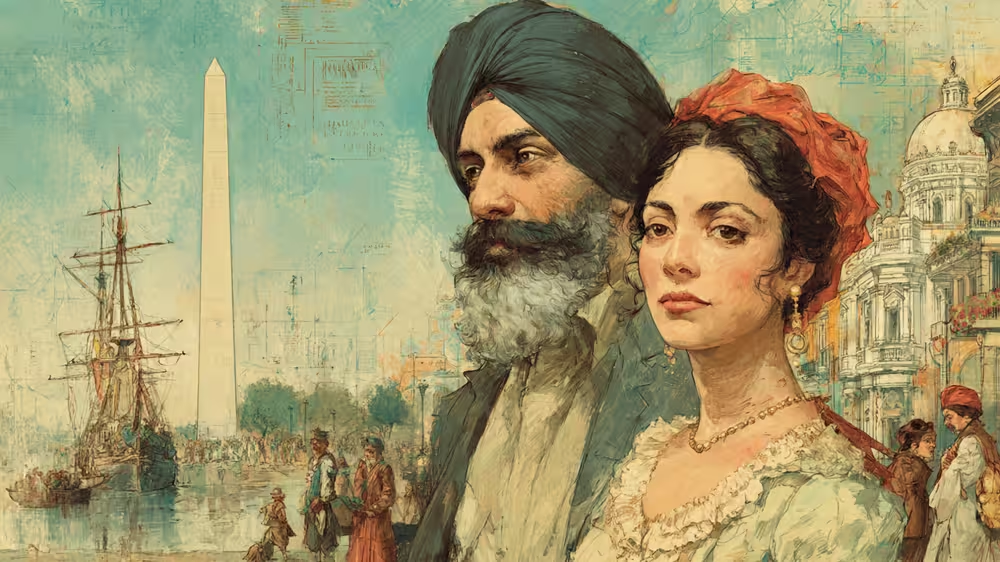Sikhs in Canada: A Historical and Cultural Journey
🧭 Introduction
The story of Sikhs in Canada is not just a tale of migration, but a testament to resilience, identity, and nation-building. From the arrival of early pioneers in the early 20th century to the vibrant community of over 770,000 today ( 2.1% of the population, according to the 2021 census), Sikhs have shaped Canada’s multicultural ethos while preserving their unique heritage. This article explores the history, contributions, and real-life stories of Sikhs in Canada—drawing upon credible sources and books to trace this compelling journey.
Canada (under British Empire 1973 ) transitioned from British rule to independence through key milestones: the British North America Act (1867) granted self-government, the Statute of Westminster (1931) provided legislative independence, and the Canada Act (1982) patriated the Constitution, ending British authority.
Early Migration and Pioneers
The Sikh presence in Canada began in 1897 when Kesur Singh, a Risaldar Major in the British Indian Army, arrived in Vancouver aboard the Empress of India to celebrate Queen Victoria’s Diamond Jubilee. This marked the start of a migration that grew with Punjabi soldiers and laborers seeking work in British Columbia’s lumber, railway, and agricultural sectors. Sarjeet Singh Jagpal’s Becoming Canadians (1994) recounts the story of these pioneers, noting how they shared tales of Canada’s “promise land” with Punjab, sparking further migration. Jagpal highlights a villager’s account: “We left with hope, carrying little but dreams, only to face a land that didn’t welcome us.”
The early 1900s saw challenges, including the 1914 Komagata Maru incident, where 376 Sikhs were denied entry due to discriminatory “continuous journey” laws. Jagpal’s book includes a survivor’s narrative: “We waited on that ship for 2 months, believing Canada would see our humanity, but it turned us away.” This event, detailed in Ali Kazimi’s Undesirables: White Canada and the Komagata Maru (2012), underscores the racism Sikhs endured, yet their determination persisted.

Modern Contributions and Real Stories
Today, Sikhs thrive across Canada, with significant populations in Brampton, Surrey, Calgary, and Edmonton. Becoming Canadians features Ujjal Singh Dosanjh, who became British Columbia’s 33rd Premier in 2000, reflecting on his journey: “From a Punjabi village to leading a province, it’s a testament to what Sikhs can achieve.” His story, alongside Navdeep Singh Bains’ rise to federal minister, highlights political influence.
Economically, Sikhs excel in business and agriculture. Johnston’s book notes Pardeep Singh Nagra, whose boxing film Tiger (2016) tells of overcoming discrimination to win titles, inspiring youth. Culturally, Lilly Singh’s rise as a comedian and late-night host, documented in her public journey, showcases Sikh creativity. These stories, from books like Jewels of the Qila and community narratives, illustrate a community that blends tradition with innovation.

Community Building and Struggles
By 1908, the first gurdwara was established in Vancouver at 1866 West 2nd Avenue (no longer an active Gurdwara), a testament to community resilience. Becoming Canadians shares how Sikhs, despite long workdays, built this space with volunteer labor, adapting it to local materials. The gurdwara became a refuge, offering langar and social support, as a carpenter from Hoshiarpur recalled: “It was our home, where we ate and planned our future.”
Racism persisted, exemplified by Naranjan Singh Grewall’s story in Hugh J.M. Johnston’s Jewels of the Qila (2012). Grewall, a Sikh businessman and MLA candidate in 1956, faced arson attacks on his mills and a suspicious death in 1957. Johnston quotes a community elder: “Grewall’s sacrifice showed us the cost of standing up, but also our strength.” This resilience fueled the community’s growth, with immigration surging post-1947 Partition.

Gurdwaras and Cultural Preservation
Gurdwaras remain central, with over 100 across Canada. The Vancouver gurdwara, evolving from a 1911 structure, symbolizes endurance. Kazimi’s Undesirables describes its role during the Komagata Maru crisis: “It was where we mourned and organized.” Modern gurdwaras, like Sri Guru Singh Sabha in Surrey, continue this legacy, hosting langar and cultural events, preserving Sikh identity amid Canada’s multicultural landscape.
Why Sikhs students move to Canada from India?
Sikh students from India, particularly from Punjab, migrate to Canada for several compelling reasons, driven by a mix of historical, economic, social, and cultural factors. Below is a detailed exploration of why Canada has become a preferred destination for Sikh students, rooted in the context of their migration patterns and aspirations.
1. Historical Ties and Established Sikh Community
Sikh migration to Canada began in the late 19th century, with early settlers like Kesur Singh arriving in 1897 as part of British military regiments. The presence of a well-established Sikh community, now numbering around 771,000 (2.1% of Canada’s population as of 2021), creates a supportive environment for new students. This diaspora, concentrated in British Columbia and Ontario, offers cultural familiarity, gurdwaras for spiritual and social support, and networks that ease integration. The historical precedent, starting with Sikh soldiers and laborers, has made Canada a “home away from home” for Punjabis, with gurdwaras like the one in Vancouver (built in 1908) serving as community hubs. Indian Express

3. Pathway to Permanent Residency
Canada’s immigration policies are relatively welcoming compared to other countries like the US or UK, where permanent residency is harder to achieve. The Post-Graduation Work Permit (PGWP) allows students to work in Canada for up to three years after completing their studies, providing a clear pathway to permanent residency through programs like the Express Entry system or Provincial Nominee Programs (PNPs). This is particularly appealing to Sikh students from Punjab, where job opportunities are limited, especially in rural areas. The prospect of settling permanently in a country with a high standard of living and better career prospects drives many to choose Canada.
5. Cultural and Religious Freedom
Canada’s multicultural policies and religious tolerance resonate with Sikh values. The country allows Sikhs to freely practice their faith, wear the Five Ks (including the kirpan, upheld in legal cases like Multani v Commission scolaire Marguerite-Bourgeoys), and maintain their cultural identity. Gurdwaras, numbering over 100 across Canada, provide spiritual and communal support, offering langar and fostering a sense of belonging. This contrasts with challenges in India, where some Sikhs feel marginalized due to historical tensions, such as the 1984 anti-Sikh pogroms and ongoing debates around the Khalistan movement. NPR.ORG
7. Challenges in Punjab
Economic and social challenges in Punjab, such as unemployment, political instability, and limited infrastructure, push students to seek better prospects abroad. The lack of quality educational institutions and job opportunities in fields like business or technology often leads students to look overseas. Additionally, historical events like the 1984 violence and perceived discrimination have fueled a desire for a safer, more stable environment. Canada’s reputation as a safe, inclusive country contrasts with these challenges, making it an attractive destination.
8. Immigration Trends and Popularity
The migration trend to Canada is deeply ingrained in Punjabi culture, with many viewing it as a status symbol or a necessary step for a better life. Social media and Punjabi media outlets amplify this by showcasing success stories of Sikhs in Canada, despite recent reports of challenges like high living costs and a strained job market. The “craze” for migration is evident in schools, where surveys show up to 87.5% of students aspire to study abroad after grade 12. This trend is not unique to Punjab but is particularly pronounced among Sikhs due to their historical diaspora and community networks.
9. Challenges and Considerations
Despite the appeal, Sikh students face challenges in Canada, including rising costs of living, housing shortages, and occasional racism, such as hate crimes targeting turbaned Sikhs. The 1914 Komagata Maru incident, where 376 mostly Sikh passengers were denied entry, remains a historical reminder of past discrimination. Recent diplomatic tensions between India and Canada, particularly over the 2023 killing of Hardeep Singh Nijjar, have raised concerns about visa processing and safety, though universities report no major policy changes affecting student admissions. Some students, like Balkar, return to India due to financial pressures or cultural disconnect, but the overall trend remains strong.
2. Educational Opportunities
Canada’s education system is a major draw for Sikh students. The country offers high-quality, globally recognized degrees at relatively affordable tuition compared to the United States or the United Kingdom. Canadian universities and colleges, especially in provinces like Ontario and British Columbia, actively recruit Indian students, with career fairs highlighting job market opportunities. For example, institutions in Nova Scotia and other regions promote programs tailored to international students, offering pathways to careers in fields like business, IT, and engineering. Study abroad experiences also foster personal growth, exposing students to new perspectives and challenging their cultural assumptions. Many Sikh students pursue programs in high-demand fields, aligning with Canada’s need for skilled workers.
4. Economic and Employment Prospects
Punjab faces challenges like limited job opportunities, particularly for youth, pushing many to seek better prospects abroad. Canada’s economy offers diverse opportunities in sectors like technology, healthcare, and agriculture, where Sikhs have historically excelled, from farming to white-collar jobs. For instance, truckers in Canada can earn more than doctors in India, offering a higher standard of living. The promise of financial stability and the ability to remit money to family in India is a significant motivator, especially for students from rural Punjabi villages
6. Social Networks and Chain Migration
The presence of family, friends, and community members in Canada encourages further migration. Many Sikh students are inspired by relatives or peers already settled in Canada, who share success stories and provide guidance. This “chain migration” is facilitated by immigration consultants and agencies in Punjab, which heavily promote student visas, though some have been criticized for scams. The trend is particularly strong in rural Punjab, where entire villages have seen significant emigration, driven by a perception of Canada as a land of opportunity.

Conclusion
Sikh students from India, especially Punjab, are drawn to Canada for its educational opportunities, pathways to permanent residency, economic prospects, and cultural compatibility. The established Sikh diaspora, with its network of gurdwaras and community support, makes integration easier, while challenges in Punjab push youth to seek better lives abroad. Despite obstacles like racism and recent diplomatic tensions, Canada’s reputation as a welcoming, opportunity-rich nation continues to attract Sikh students, sustaining a century-long migration trend.














